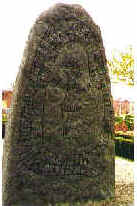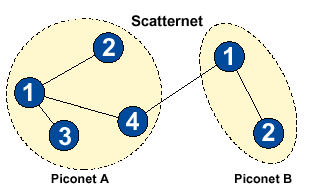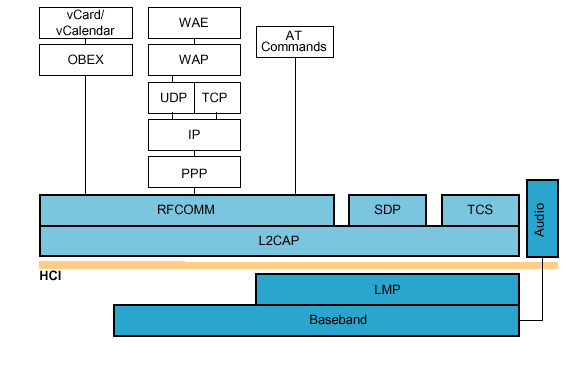 |
 |
The Bluetooth Wireless Technology |
Harald Bluetooth Harald Bluetooth was a Viking and king of Denmark between 940 and
981. One of his skills was to make people talk to each other, and during
his rule Denmark and Norway were Christianized and united. In the Danish town of Jelling Harald Bluetooth raised
an enormous rune stone which still stands in its original position. It
has the following runic inscription, adorned with an image of Christ:
„King Harald raised this monument to the memory of Gorm his father and
Thyre his mother, that (same) Harald which won all Denmark and Norway
and made the Danes Christian.š Originally the stone was painted. |
 |
The First Steps The idea that resulted in the Bluetooth wireless
technology was born in 1994 when Ericsson Mobile Communications decided
to investigate the feasibility of a low-power, low-cost radio interface
between mobile phones and their accessories. The idea was that a small
radio built into both the cellular telephone and the laptop would
replace the cumbersome cable used today to connect the two
devices. In February 1998 the Special Interest Group (SIG)
was formed. Today the Bluetooth SIG includes promoter companies 3Com,
Ericsson, IBM, Intel, Lucent, Microsoft, Motorola, Nokia and Toshiba,
and thousands of Adopter/Associate member companies. The assignment of
the SIG originally was to monitor the technical development of short
range radio and to create an open global standard, thus preventing the
technology from becoming the property of a single company. This work
resulted in the release of the first Bluetooth Specification in July
1999. The further development of the Specification still is one of the
main issues for the SIG, other important tasks are interoperability
require-ments, frequency band harmonization and promotion of the
technology. Learn more about the Bluetooth SIG at http://www.bluetooth.com/ From the very start one of the main goals for the SIG
has been to include a regulatory framework in the Specification that
will guarantee full interoperability between different devices from
various manufacturers - as long as they share the same Profile. While
the usage models describe applications and intended devices, the
Profiles specify how to use the Bluetooth protocol stack for an
interoperable solution. In each Profile it is stated how to reduce
options and set parameters in the base standard, how to use procedures
from several base standards. A common user experience is also defined.
For exam-ple, a computer mouse doesn‚t need to communicate with a
headset, and so they are built to comply with different profiles. The
Profiles are a part of the Bluetooth Specification, and all devices must
be tested against one or more of the Profiles in order to fulfil the
Bluetooth certification requirements. The number of Profiles will
continue to grow as new Bluetooth applications arise. Many companies have declared that Bluetooth
wireless technology will be incorporated into their products, especially
when components becomes cheaper. In a forecast made by Cahners In-Stat
Group (July 2000), the product availability during the next couple of
years was defined as three waves. The first wave is believed to occur around the
turn of the year 2000/2001 and will include products like: Adapters for mobile phones and adapters (dongles) and PC Cards for
notebooks and PCs High-end mobile phones and notebook PCs with integrated Bluetooth
communication for the business users. Bluetooth headsets are expected to enter the market by the first
half of 2001. Cordless phones, handheld PCs, and PDAs will also be included in
this first wave. The first handheld PCs and PDAs are expected to
enter the market during 2001. The second wave will in many respects
overlap the first. What we will see here is: The third wave will include Especially after the first wave is completed
the cost and development time of e-menu will decrease enormously since
we will not need to use the bluetooth hardware seperately. At the
time that is market is ready for bluetooth and PDA applications, Crein
will be there. |
|
| Why Bluetooth wireless technology?
In phase with the IT-boom the mobility among people has constantly grown and wireless technologies for voice and data have evolved rapidly during the past years. Countless electronic devices for home, personal and business use have been presented to the market during recent years but no widespread technology to address the needs of connecting personal devices in Personal Area Networks (PAN). The demand for a system easily could easily connect devices for transfer of data and voice over a short distances - cables, grew stronger. The Bluetooth wireless technology fill this important communication need, with its ability to communicate both voice and data wirelessly, using a standard low-power, low-cost technology which can be integrated in all devices and thus enable total mobility. The price will be low and result in mass production. The more units around, the more benefits for the customers. The Bluetooth Specification defines a short
(around 10 m) or optionally a medium range (around 100 m) radio link
capable of voice or data transmission to a maximum capacity of 720 kbps
per channel. Radio frequency operation is in the unlicensed
industrial, scientific and medical (ISM) band at 2.4 to 2.48 GHz, using
a spread spectrum, frequency hopping, full-duplex signal at up to 1600
hops/sec. The signal hops among 79 frequencies at 1 MHz intervals to
give a high degree of interference immunity. RF output is specified as 0
dBm (1 mW) in the 10m-range version and -30 to +20 dBm (100 mW) in the
longer range version. When producing the radio specification, high emphasis
was put on making a design enabling single-chip implementation in CMOS
circuits, thereby reducing cost, power consumption and the chip size
required for implementation in mobile devices. A Master can share an asynchronous channel with up to 7
simultaneously active slaves in a Piconet. Slaves can participate in different piconets and a
master of one Piconet can be the slave in another, this is known as a
Scatternet. Up to 10 piconets within range can form a Scatternet, with a
minimum of collisions. |
|
| Network Architecture
Bluetooth units that come within range of each
other can set up ad hoc point-to-point and/or point-to-multipoint
connections. Units can dynamically be added or disconnected to the
network. Two or more Bluetooth units that share a channel form a
piconet. |
 |
Hardware Architecture The Bluetooth hardware consists of an
analog radio part and a digital part - the Host Con-troller. The Host
Controller has a hardware digital signal processing part called
the |
|
|
Below, you can see the current and estimated
hardware evolution. |
|
Software Architecture The Bluetooth protocols are marked with blue
color in the illustration below. In order to make different hardware
implementations compatible, Bluetooth devices use the Host Controller
Interface (HCI) as a common interface between the Bluetooth host (e.g. a
por-table PC) and the Bluetooth core. |
|
|
|
|
*This article is taken from "Beginner's Guide" by Ericsson.

